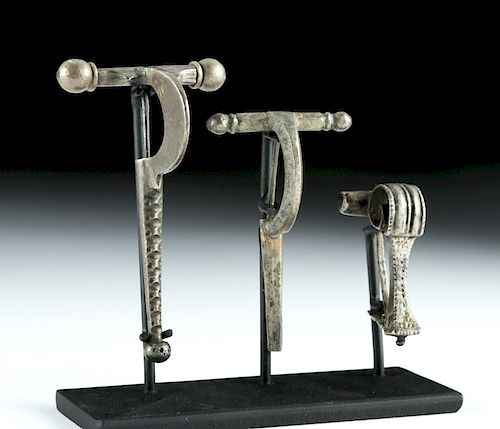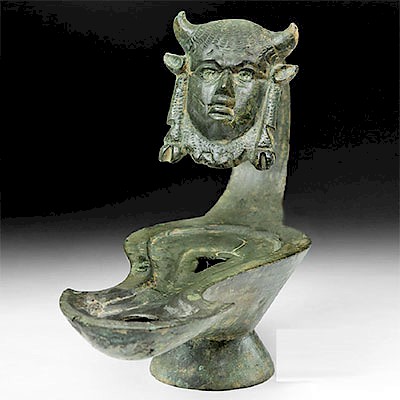Lot of 3 Roman Copper-Silver Alloy Military Fibulae
Lot 56a
About Seller
Artemis Fine Arts
686 S Taylor Ave, Ste 106
Louisville, CO 80027
United States
Selling antiquities, ancient and ethnographic art online since 1993, Artemis Gallery specializes in Classical Antiquities (Egyptian, Greek, Roman, Near Eastern), Asian, Pre-Columbian, African / Tribal / Oceanographic art. Our extensive inventory includes pottery, stone, metal, wood, glass and textil...Read more
Estimate:
$900 - $1,400
Absentee vs Live bid
Two ways to bid:
- Leave a max absentee bid and the platform will bid on your behalf up to your maximum bid during the live auction.
- Bid live during the auction and your bids will be submitted real-time to the auctioneer.
Bid Increments
| Price | Bid Increment |
|---|---|
| $0 | $25 |
| $300 | $50 |
| $1,000 | $100 |
| $2,000 | $250 |
| $5,000 | $500 |
| $10,000 | $1,000 |
| $20,000 | $2,500 |
| $50,000 | $5,000 |
| $100,000 | $10,000 |
| $200,000 | $20,000 |
About Auction
By Artemis Fine Arts
Sep 27, 2018
Set Reminder
2018-09-27 10:00:00
2018-09-27 10:00:00
America/New_York
Bidsquare
Bidsquare : Antiquities | Asian | Ethnographic
https://www.bidsquare.com/auctions/artemis-gallery/antiquities-asian-ethnographic-3469
Featuring classical antiquities, ancient and ethnographic art from cultures encompassing the globe. Artemis Fine Arts info@artemisgallery.com
Featuring classical antiquities, ancient and ethnographic art from cultures encompassing the globe. Artemis Fine Arts info@artemisgallery.com
- Lot Description
Roman to Byzantine, late Imperial period, ca. 280 to mid 6th century CE. A trio of beautiful copper-silver alloy "crossbow" fibulae (brooches) used to fasten the cloaks of Roman soldiers and citizens. Each is cruciform, two with round bosses on the terminals (the third has squared off terminals), and a flat tailpiece. Each is decorated with incised lines and/or dots, likely made using an awl. A thick silver pin is present on the back of each for fastening. Brooches of this style were in vogue in the late Roman Empire, especially amongst elites; they are similar to those found in contemporary Baltic tribes during the early Migration period and probably represent a mixing of cultures during this volatile time period. Some of the known examples have overt Christian symbols, as the gold one at the Metropolitan Museum of Art (https://www.metmuseum.org/art/collection/search/466286) with its openwork cross on the tailpiece. Size of largest: 0.95" L x 1.5" W x 2.35" H (2.4 cm x 3.8 cm x 6 cm); 3" H (7.6 cm) on included custom stand.
Provenance: ex-collection of Nicholas Kronwall, Arizona, USA; acquired from Greg Manning Galleries, New Jersey, USA, 1996
All items legal to buy/sell under U.S. Statute covering cultural patrimony Code 2600, CHAPTER 14, and are guaranteed to be as described or your money back.
A Certificate of Authenticity will accompany all winning bids.
We ship worldwide and handle all shipping in-house for your convenience.
#138208Attractive surface patina with very slight scratching, mainly on the tailpiece. Pin is not frozen in place, but is delicate and should not be moved. Overall very nice condition.Condition
- Shipping Info
-
All shipping is handled in-house for your convenience. Your invoice from Artemis Gallery will include shipping calculation instructions. If in doubt, please inquire BEFORE bidding for estimated shipping costs for individual items.
-
- Buyer's Premium



 EUR
EUR CAD
CAD AUD
AUD GBP
GBP MXN
MXN HKD
HKD CNY
CNY MYR
MYR SEK
SEK SGD
SGD CHF
CHF THB
THB














